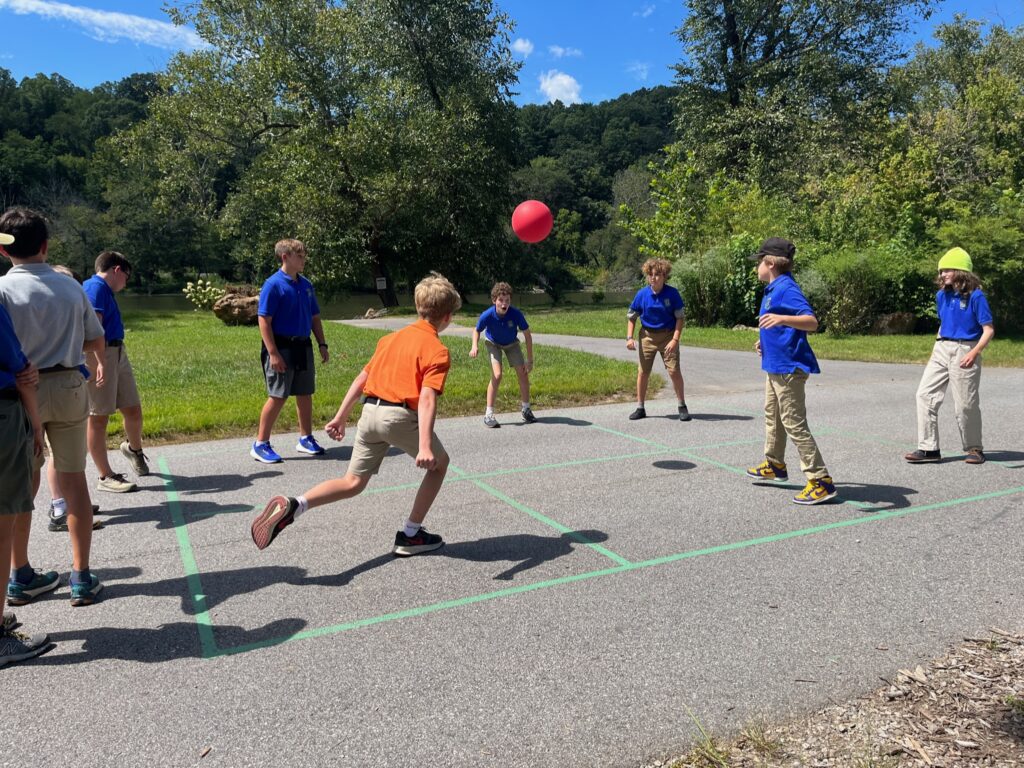By Alex Black, Boys Program Dean of Students
We’re sitting, two teachers and twelve 7th graders, in a circle just a few steps off of the trail we’ve been hiking on. One student, who has been chosen by his peers to be today’s “Speaker Keeper,” looks around at the class and asks if anyone has any conflicts to bring up. A raised hand, a nod, and then it comes out:
“Sometimes when we are playing four square, and someone gets out, I notice that they kind of rage and slam the ball down on the ground. It seems like they’re joking, but then everyone has to stop playing to get the ball, and it makes it feel less fun for me. I’ve done this sometimes too, but I really think we should try to stop so we have more time to play, and more fun together.”

We’re in a familiar ritual for a FBRA Boys Program class: the community meeting. The strength of our shared bonds is what makes our school work, and so each class takes time, usually once a month, to sit down together and tend to our community.
A community meeting at FBRA follows a familiar structure. We begin, as we do most shared moments at school, with a mindfulness moment to help everyone be present. Then someone (usually a student) asks a get-to-know-you question for everyone to answer. And then we get into the meat of the meeting: conflict resolution.
As in the example above, a good number of conflicts that students want addressed revolve around four square. But there’s surprising variety as well: students bring up how it’s hard for their class to stay on track in a particular academic subject area; they tell two classmates who like to use sarcasm that they’ve hurt people’s feelings with their tone before; someone talks about how he thinks people are talking about him behind his back. We teach students a simple initialism to follow when raising a conflict:
- Concern – what, briefly, is the problem that is bothering me?
- Feeling – how does it make me feel or what other negative effects am I noticing?
- Ownership – can I identify any way in which I’ve contributed to this dynamic or problem?
- Request – what would I like to ask my classmates for in order to resolve this problem?
The four square example above, despite not using any of these four words, actually uses this structure perfectly!
Students then discuss the problem – some will chime in to agree with the original speaker, others will ask clarifying questions. Eventually, we come up with a specific action that everyone in the class can take to help resolve the problem, and each person gives their verbal assent. And then the Speaker Keeper asks for another conflict to be brought forth. In 6th grade, much of this facilitation is done by teachers, to model compassionate communication and walk students through what can be a complex process. We loosen the reins as students progress through the school, and I’ve sat in a spring of 8th grade community meeting where my only contribution was to congratulate the students on a respectful and productive discussion.
A funny thing happens when we let students bring up and address their own conflicts: they often notice the same interpersonal and behavioral problems that we teachers do. So why not just tell the students what the issue is, and give them a solution? When students direct the process of conflict resolution, they’re automatically more bought in to solving whatever problem they’ve identified. Our conversations during community meetings can get tense, but they are rarely boring to students.
Another, less immediate, benefit of the ownership students gain over their communities through these meetings is seen in the teacher-student relationship that underpins so much of the FBRA model. Without students trusting teachers, they’d never agree to follow us down class III rapids; without our trust in them, it would be irresponsible to bring them into our Costa Rican host families’ homes. Since students determine the content of these meetings with the teachers acting as occasional facilitators, they begin to see us as collaborators, rather than obstacles. For our part, we use community meetings to understand what challenges a class or individual are facing; that knowledge proves instrumental in continuing to help them grow.
Finally, the skills students learn during community meetings reverberate throughout the rest of their FBRA career. We explicitly teach students how to listen with the intent to understand, not the intent to respond; we coach them on using “I” statements so they can speak from their perspective and not assume someone else’s; and we show them the importance of leaving a hard conversation with everyone on the same page about the next steps. I am frequently impressed by their ability to handle conflict with grace and compassion, especially when I sit down to help a small group of students work through a challenging interpersonal problem, and I know this knowledge will serve them well in high school and beyond.
Conflict resolution can be heavy, even when everyone ends on the same page. And so, community meetings always finish the same way: each student shares something that a classmate has done that they were grateful for. These “appreciations” can range from “…made me laugh while we were canoeing” to “…is always there for me when I need someone to talk to.” We want all our students to leave the circle remembering that FBRA is a community where we have each others’ backs, where we see the best in everyone, and where proactively addressing conflict is an invitation to connect more deeply.
